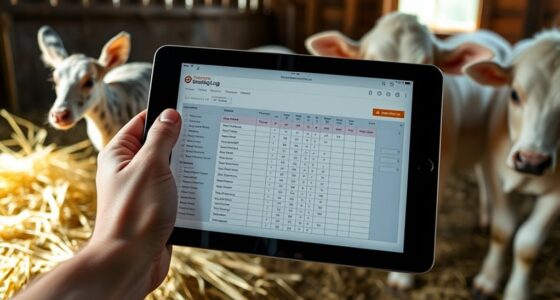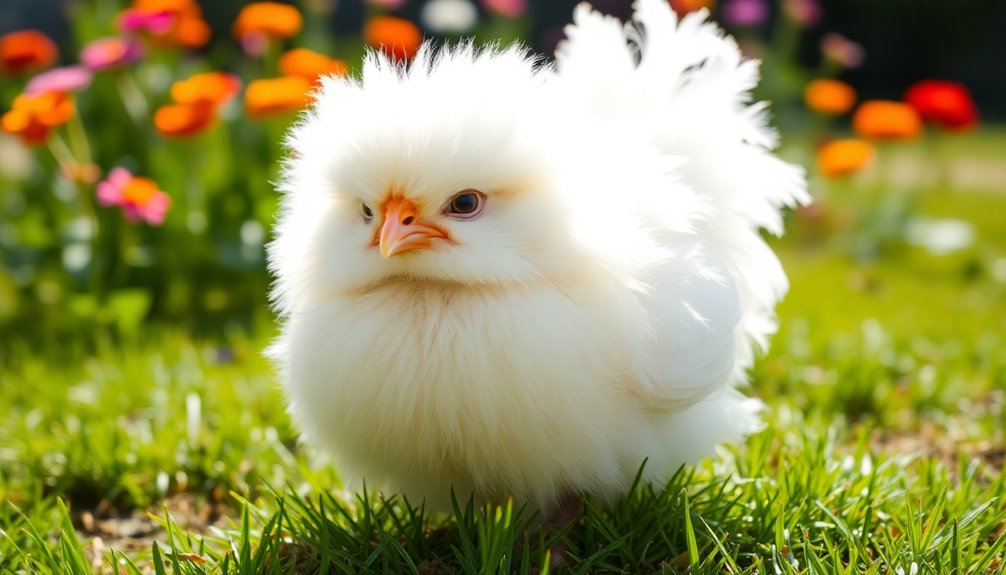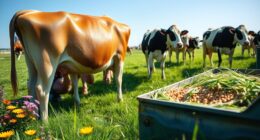In August, plan to wean your meat goat kids between 8-12 weeks, considering environmental factors like weather and forage availability. Gradually shift them from milk to solid feeds while minimizing stress by keeping routines calm and consistent. Monitor their health and growth closely, adjusting nutrition with high-quality forage and supplements as needed. Use gentle handling and proper shelter to ease weather-related challenges. Keep these tips in mind, and you’ll set your herd up for successful weaning.
Key Takeaways
- Wean kids between 8-12 weeks, ensuring environmental conditions support healthy growth and minimize stress.
- Gradually replace milk with high-quality forage and supplements to meet nutritional needs during transition.
- Monitor health regularly, vaccinate, and control parasites to prevent illness and support development.
- Use gentle handling and consistent routines to reduce stress during weaning, separation, and management practices.
- Provide shelter, adapt to weather conditions, and select resilient breeds to promote smooth weaning in changing environments.
Assessing the Optimal Timing for Weaning in August
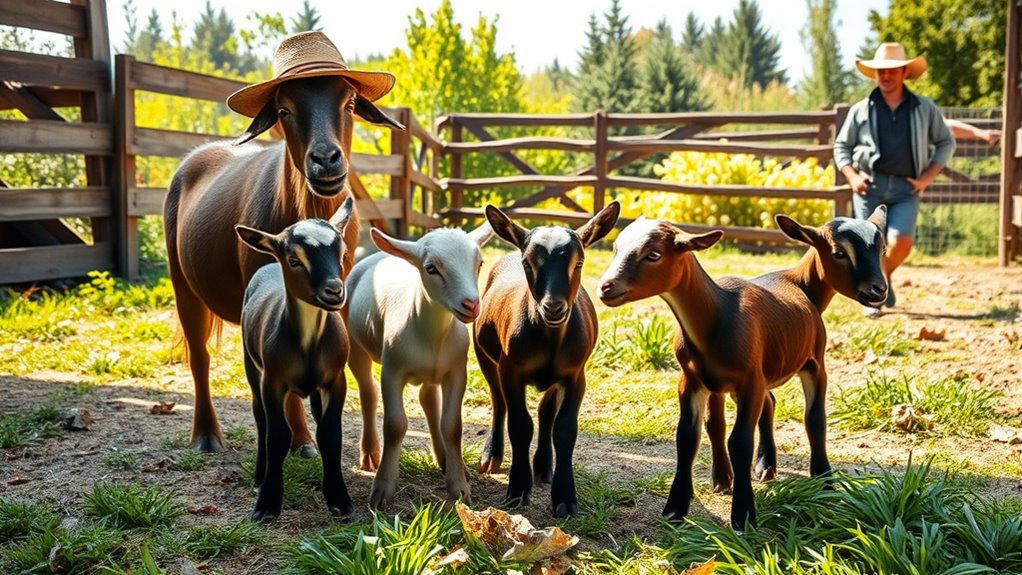
Determining the right time to wean meat goat kids in August requires careful consideration of several factors. Weaning age considerations are vital; most kids are ready between 8 to 12 weeks, but environmental conditions can influence this timing. Conducting an environmental impact assessment helps you evaluate how weaning might affect your herd and the surrounding ecosystem. For example, early weaning can reduce grazing pressure and manure buildup, minimizing potential environmental stress. Conversely, delaying weaning might lead to overgrazing or health issues due to insufficient nutrition. By weighing these factors, you can select a weaning time that promotes healthy growth while maintaining environmental sustainability. Additionally, understanding pinball machine weight is crucial if you’re considering installing equipment in your facility, as it impacts transportation and setup. Considering nutritional needs throughout the weaning process is also essential to ensure the kids’ health and growth are not compromised. Proper management of weaning stress can further improve outcomes and reduce complications during this transition. This strategic approach ensures your herd’s well-being and minimizes ecological impact during August, and being aware of available weaning methods can help tailor your approach to best suit your herd’s specific circumstances. Additionally, monitoring vaccine schedules and health records can help prevent illness during the stressful weaning period.
Preparing Your Herd for the Transition
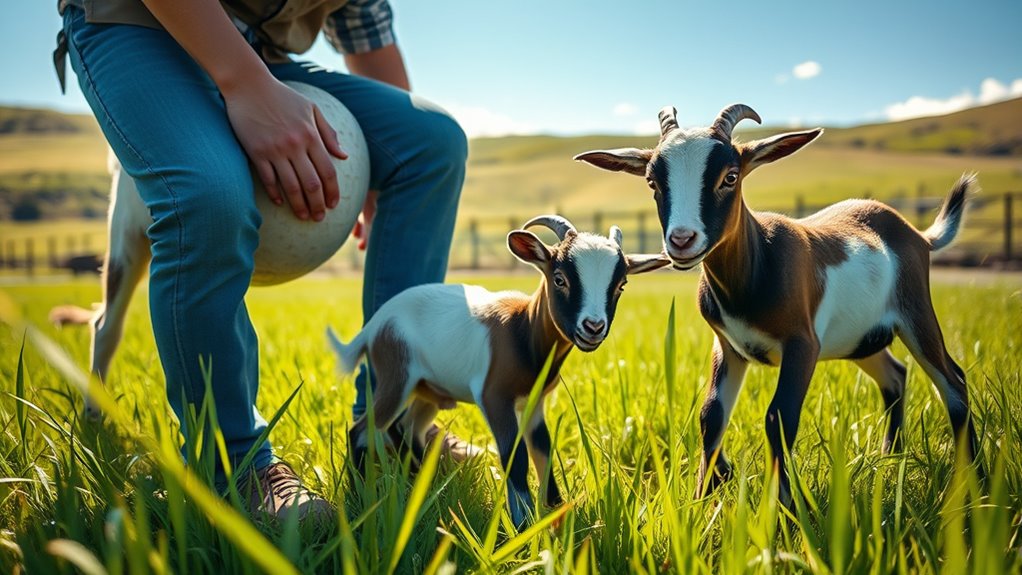
To prepare your herd for weaning, start by closely monitoring their health and addressing any issues early. You should also adjust feeding routines to guarantee they’re getting proper nutrition during this changeover. Additionally, minimize stress by creating a calm environment and reducing sudden changes that could unsettle the kids. Incorporating digital literacy programs can also help caregivers stay informed about effective weaning practices and health monitoring techniques. Staying updated on automation technologies used in livestock management can further optimize your herd’s transition process. Understanding nutrient-rich ingredients can assist in providing balanced diets and reducing the risk of deficiencies during this critical period. Implementing proper nutrition strategies ensures that goats receive the necessary nutrients to support growth and health, making the transition smoother. Emphasizing early morning feeding schedules can also help ease the transition and reduce stress for the kids.
Monitor Herd Health
As you prepare your herd for weaning, closely monitoring their health becomes essential to guarantee a smooth transition. Check for signs of illness, stress, or nutritional deficiencies, as these can affect growth and market readiness. Good herd health supports optimal breed selection, ensuring your goats are strong and healthy for market timing. Regular vaccinations and parasite control help prevent disease outbreaks that could disrupt your plans. Keep a close eye on individual animals, noting any changes in behavior, appetite, or appearance. Consistent health checks allow you to identify issues early and address them promptly. Maintaining herd health minimizes setbacks and guarantees your goats are well-prepared for weaning, ultimately aligning with your market goals and maximizing profit.
Adjust Feeding Routines
Adjusting feeding routines is a pivotal step in preparing your herd for weaning, ensuring they shift smoothly from milk to solid feed. Gradually introduce high-quality forage and pellets, reducing milk reliance over time. Consistent routines help kids adapt without stress. Incorporate goat grooming to keep kids healthy and comfortable, which supports their ability to eat solid foods. Additionally, implement pasture rotation to promote fresh forage intake and prevent overgrazing, encouraging natural feeding behaviors. Use this table to plan your approach:
| Feeding Stage | Key Actions |
|---|---|
| Pre-Weaning | Gradually replace milk with solid feed |
| Transition | Increase forage, reduce milk intake |
| Post-Weaning | Fully rely on solid feed, maintain pasture rotation |
This approach helps kids adapt efficiently, supporting healthy growth and development. Proper nutrition during this period is essential for growth and overall health.
Minimize Stress Factors
Minimizing stress factors is essential for a smooth weaning process, as stress can lead to health issues and hinder acceptance of solid feeds. To reduce stress, ensure your herd’s vaccination schedule is up to date, preventing disease outbreaks that can weaken their immune systems. Maintain consistent routines for feeding, handling, and environment to create a calm atmosphere. Proper parasite control is also vital, as parasites can cause discomfort and weaken kids during this transition. Avoid sudden changes and handle animals gently to prevent anxiety. Providing a clean, comfortable space helps them feel secure. Additionally, understanding electric power generation can inform you about energy-efficient practices to maintain proper lighting and equipment in your barn. Efficient energy use can also help reduce operational costs, allowing you to focus resources on animal care. Regularly inspecting and maintaining your air purification systems ensures a healthy environment free from airborne pathogens, supporting overall herd health. Implementing proper ventilation strategies can further improve air quality and reduce respiratory issues during weaning. Incorporating climate control techniques can also help maintain optimal conditions, reducing the stress caused by temperature fluctuations. By managing these factors, you support healthier, more adaptable kids, making the weaning process less traumatic and easier for both you and your herd.
Nutritional Management During and After Weaning
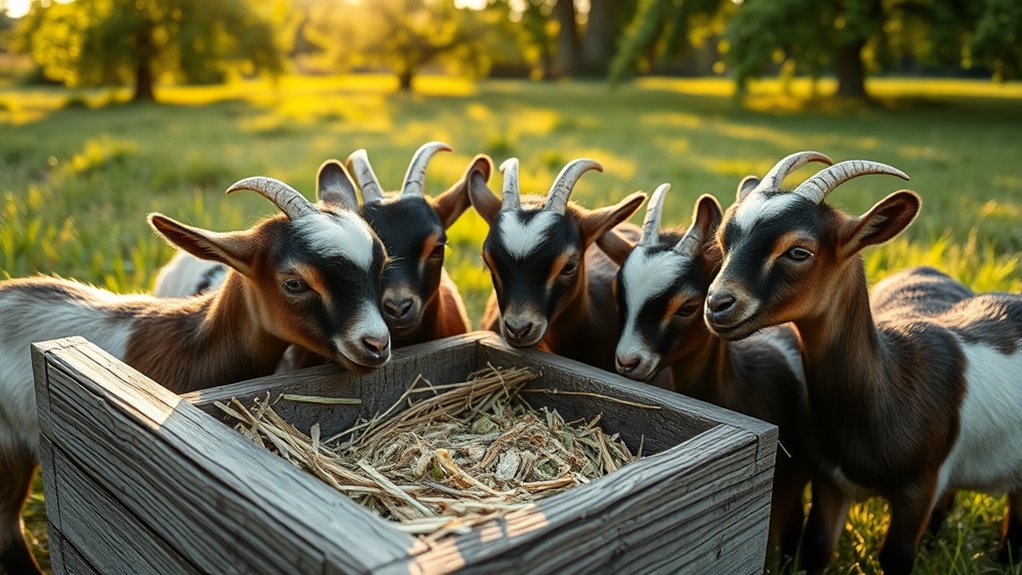
Proper nutritional management during and after weaning is essential to guarantee meat goat kids grow efficiently and stay healthy. To achieve this, focus on three key aspects:
Effective nutrition during and after weaning ensures healthy, efficient growth in meat goat kids.
- Provide balanced diets with adequate energy and protein to support growth. Ensuring the diet meets the foraging needs of the kids supports efficient growth and development. Incorporating nutrient-dense foods can further enhance their overall health and growth potential.
- Offer supplemental minerals to prevent deficiencies and promote overall health.
- Incorporate parasite control strategies, such as targeted deworming, to reduce stress and improve nutrient absorption. Ensuring the environment is kept clean and free from parasite habitats also contributes to better health outcomes.
Maintaining nutritional balance is crucial for preventing post-weaning setbacks and promoting steady growth. Incorporating effective parasite management practices can significantly enhance nutrient utilization and overall health. Together, these practices foster healthy growth, reduce post-weaning setbacks, and optimize your herd’s productivity.
Techniques to Minimize Stress for Young Goats
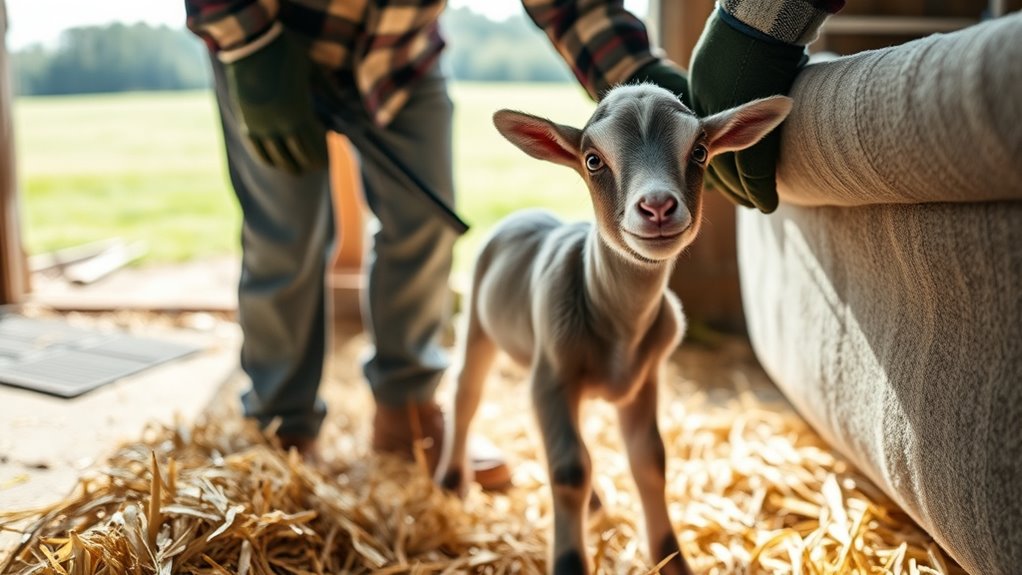
Stress reduction is crucial during and after weaning because it helps young goats adapt quickly and maintain health. Using proper weaning equipment, like barriers or separation pens, minimizes abrupt changes. Gradually introducing goat training techniques, such as gentle handling and positive reinforcement, eases their transition. Incorporate familiar scents or routines to reduce anxiety. Here’s a quick overview:
| Technique | Equipment Used | Goal |
|---|---|---|
| Gradual Separation | Partitioned pens, fences | Reduce shock and anxiety |
| Positive Reinforcement | Treats, calm voice | Build trust and confidence |
| Familiar Routine | Consistent feeding times | Create sense of security |
| Gentle Handling | Slow, calm movements | Minimize fear and stress |
Implementing these techniques ensures a smoother, less stressful weaning process for your young goats. Consistent routines can also help in establishing a predictable environment that further reduces stressors.
Managing Forage and Feed Resources Post-Weaning
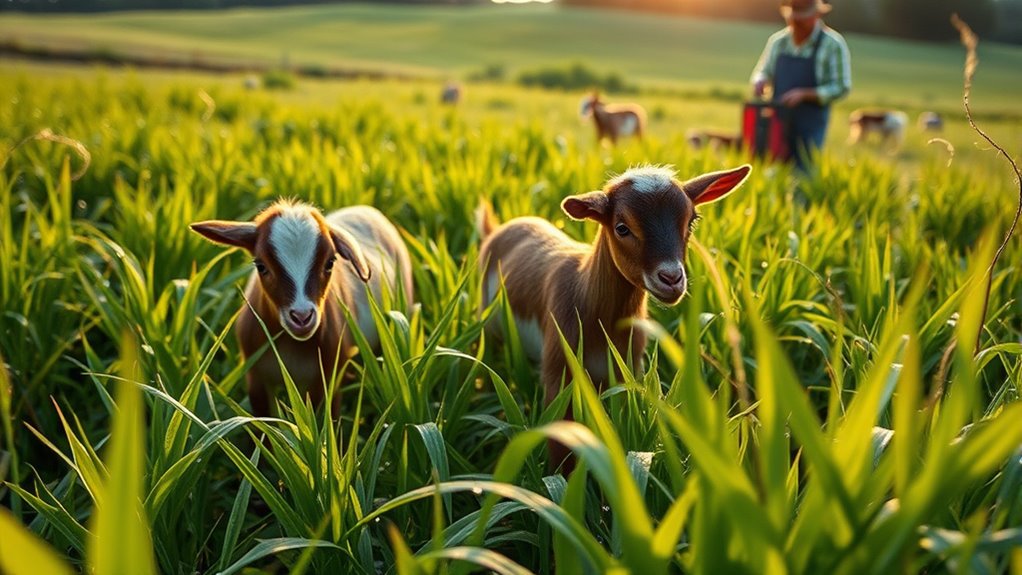
After weaning, managing forage and feed resources becomes essential to support the growth and health of your young goats. Proper nutrition guarantees they stay healthy during the breeding season and are prepared for future challenges. Focus on these three steps:
- Provide high-quality forage that meets their nutritional needs, promoting steady growth.
- Supplement with concentrates if forage alone isn’t sufficient, especially during peak energy demands.
- Maintain a consistent feeding schedule, and monitor for signs of nutritional deficiencies or excesses.
Additionally, ensure your herd vaccination schedule is up-to-date to prevent disease outbreaks. Proper feed management supports immune function and helps kids recover from weaning stress, setting a foundation for successful breeding and overall herd health.
Monitoring Growth and Health Following Weaning
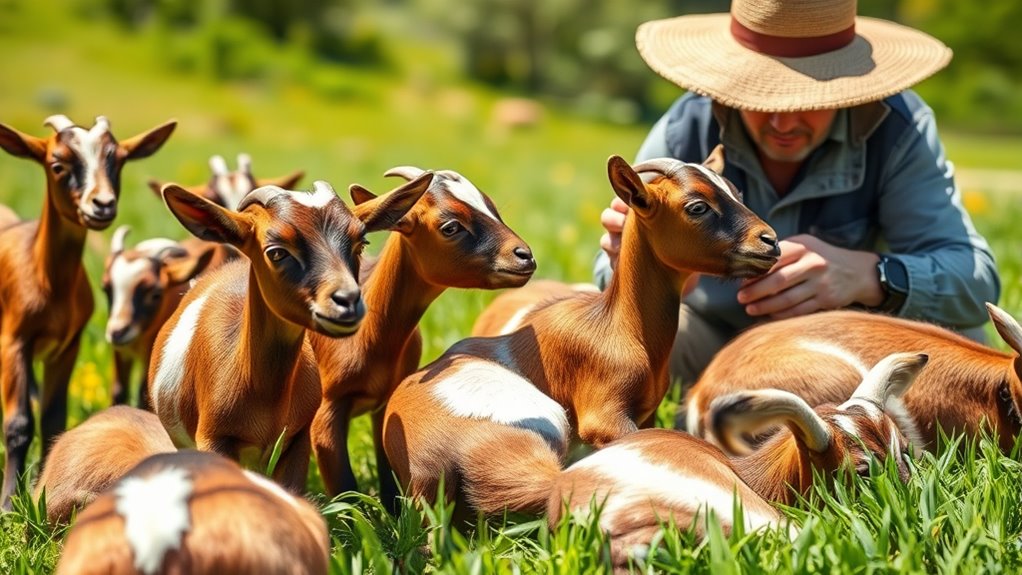
Monitoring the growth and health of your goat kids after weaning is essential to catching potential issues early and ensuring they develop properly. Regularly weigh your kids to track growth rates and identify any that may be lagging. Pay attention to their overall condition, observing for signs of illness or parasite problems, which can hinder development. Incorporate genetic selection into your monitoring by evaluating how well specific traits, like growth rate and parasite resistance, are expressed in your herd. Effective parasite control is vital during this period, as young goats are especially vulnerable to internal and external parasites. By staying vigilant and adjusting your management practices as needed, you’ll promote healthier growth and set your kids up for a productive future.
Tips for Successful Weaning in Changing Weather Conditions
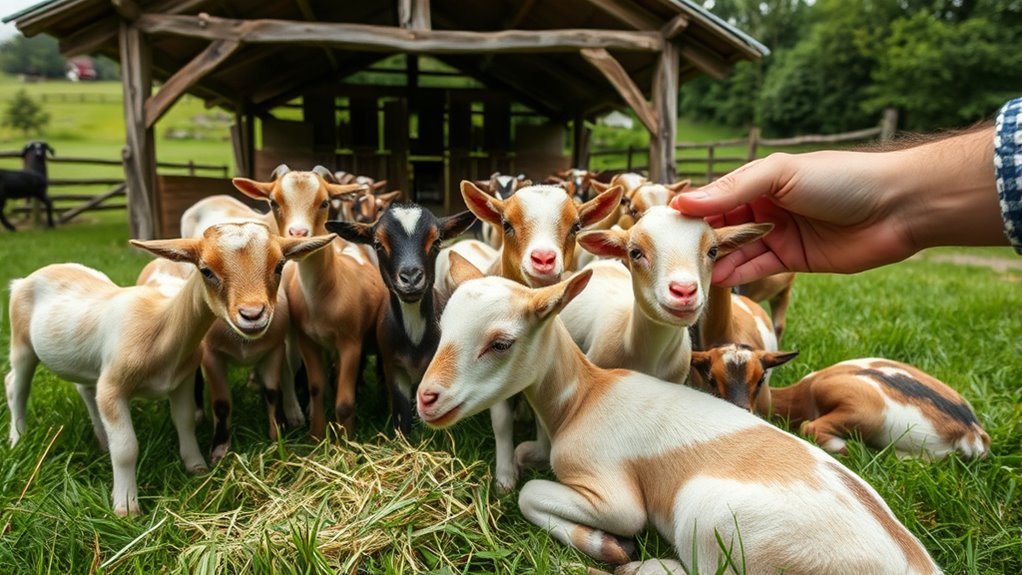
Changing weather conditions can pose challenges during the weaning process, but you can help guarantee a smooth transition by adjusting your management practices accordingly. Climate adaptation is key; monitor temperature and humidity shifts to prevent stress. Consider breed selection carefully—choose breeds with resilience to local weather patterns to improve success. To adapt effectively:
- Provide shelter to shield kids from sudden temperature drops or rain.
- Adjust feeding schedules and provide extra nutrients if weather causes stress or reduces forage quality.
- Gradually wean kids over a longer period to help them acclimate to temperature fluctuations.
These steps help reduce weather-related stress and support healthy growth, ensuring your goats adapt well despite changing conditions. Proper planning makes climate adaptation smoother and improves overall weaning success.
Frequently Asked Questions
How Can I Identify Signs of Readiness for Weaning in Goat Kids?
To identify signs of readiness for weaning, observe your goat kids’ feeding behavior and physical development. When they start eating more solid food and less milk, it indicates they’re ready. Look for steady growth, good body condition, and increased independence during feeding. If they’re actively exploring and showing strong physical development, it’s a good sign they can handle weaning. Trust these cues to determine the right time.
What Are Common Health Issues to Watch for After Weaning?
Once you’ve crossed that bridge, keep a close eye on your goats, as problems can crop up unexpectedly. Watch for signs of nutritional deficiencies like lethargy or poor growth, and make certain parasite management is on point to prevent health setbacks. Post-weaning, goats might struggle to adapt, so monitor their behavior, appetite, and fecal consistency regularly. Staying vigilant helps catch issues early and keeps your herd healthy and thriving.
How Do I Handle Weaning During Unexpected Weather Changes?
When facing weather disruptions during weaning, you should prioritize stress mitigation to keep your goats healthy. Provide a sheltered, dry area to protect them from rain or extreme temperatures, and reduce handling to minimize additional stress. Keep their environment calm and consistent, and monitor them closely for signs of discomfort or illness. Adjust feeding routines if necessary to ensure they stay well-nourished despite the weather changes.
What Are the Best Supplements to Support Kids Post-Weaning?
Imagine your goat kids transforming from fragile babies into mighty, thriving animals—post-weaning is vital! You should give them mineral supplements to fill nutritional gaps and boost their immunity. Digestive aids are also indispensable to prevent bloating and guarantee smooth digestion. These supplements support healthy growth, help them adapt to new diets, and keep them energetic. With proper support, your kids will become robust, vigorous goats ready to conquer any pasture.
How Can I Ensure Consistent Growth Rates After Weaning?
To guarantee consistent growth rates after weaning, focus on effective nutrition management and disease prevention. Provide a balanced diet that includes high-quality forage and supplemented grains to meet energy and protein needs. Regular health checks and vaccinations help prevent illnesses that can hinder growth. Monitor your kids closely, adjust feed as needed, and maintain cleanliness to support their development. This approach promotes healthy, steady growth post-weaning.
Conclusion
By carefully timing your August weaning and managing nutrition, you can reduce stress and promote healthy growth in your meat goat kids. Did you know that properly managed weaning can improve growth rates by up to 15%? Staying attentive to weather changes and monitoring your goats’ health guarantees a seamless shift. With these strategies, you’ll set your herd up for success, even in unpredictable August conditions. Your efforts will lead to stronger, healthier goats ready for market or breeding.



